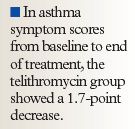- Safety & Recalls
- Regulatory Updates
- Drug Coverage
- COPD
- Cardiovascular
- Obstetrics-Gynecology & Women's Health
- Ophthalmology
- Clinical Pharmacology
- Pediatrics
- Urology
- Pharmacy
- Idiopathic Pulmonary Fibrosis
- Diabetes and Endocrinology
- Allergy, Immunology, and ENT
- Musculoskeletal/Rheumatology
- Respiratory
- Psychiatry and Behavioral Health
- Dermatology
- Oncology
TELICAST trial of telithromycin produces split results in asthma treatment
A double-blind, randomized, placebo-controlled study of the ketolide telithromycin administered orally over a 10-day period to 278 asthma patients demonstrated a reduction in asthma symptoms, but did not show a significant treatment effect on patients' morning peak expiratory flow.

The Telithromycin, Chlamydophila, and Asthma (TELICAST) trial also found no relationship between the bacteriologic status of patients and their response to asthma treatment.
At baseline, mean (±SD) scores testing asthma symptoms were measured on a 7-point scale with 0 signifying no symptoms and 6 denoting severe symptoms. Mean symptom scores at baseline were 3.0±1.4 for the telithromycin group and 2.8±1.3 for the placebo group.
In the first primary end point, the telithromycin group demonstrated a greater mean decrease in asthma symptom scores from baseline compared with the placebo group during the treatment period (mean difference=–0.03 point; 95% CI, –0.05 to –0.01; P=.004), resulting in a 40.4% reduction in symptoms compared with a 26.5% reduction in the placebo group (mean difference=–13.9 percentage points; 95% CI, –23.4 to –4.3; P=.005). A significant treatment-related difference was not observed in the home-recorded morning measurements of peak expiratory flow (P=.28), the second primary end point.
In the secondary end point of mean decrease in asthma symptom scores from baseline to end of treatment, the telithromycin group demonstrated a 1.7-point decrease compared with a 1.3-point decrease in the placebo group (mean difference=–0.4 points; 95% CI, –0.7 to –0.2; P=.002). The telithromycin group also demonstrated some improvement in symptom scores throughout the entire study period, with a mean decrease from baseline of 1.6 points compared with a decrease from baseline of 1.4 points for the placebo group (mean difference= –0.2 points; 95% CI, –0.5 to 0.02; P=.066). Those receiving telithromycin also had a greater improvement in FEV1 from baseline to the end of treatment (mean difference=.29 L; 95% CI, 0.12–0.46; P=.001).
"This report should prompt clinicians to assess carefully the role of telithromycin in the management of acute asthma," stated Frédéric Little, MD, Boston University School of Medicine Pulmonary Center, in an editorial that accompanied the article in NEJM. "A benefit in certain but not all efficacy end points is not uncommon in clinical study of the efficacy of asthma drugs, but such inconsistency does limit the conclusiveness of the study findings. It clearly establishes the foundation for additional direct examination of this therapeutic opportunity in asthma. It is time for further study, not for treatment."
Researchers also tested for the presence of Chlamydophila pneumoniae or Mycoplasma pneumoniae in patients to compare the effects of treatment between patients with and without signs of acute infection. Using mostly serologic criteria, positive tests for C pneumoniae, M pneumonia, or both were received from 61% of patients in the study. Treatment with telithromycin resulted in a mean 0.67 L improvement in FEV1 within the subgroup of patients with signs of acute infection at baseline compared with 0.38 L in the placebo group (mean difference=0.29 L; 95% CI, 0.11–0.47; P=.002). No other statistically significant differences in treatment effect were found between subgroups, and neither subgroup showed significant treatment effects.
A post-hoc subgroup comparison of patients who received investigator-prescribed oral corticosteroids and patients who did not revealed no significant difference in mean change from baseline during the treatment period.
"It is striking that nearly two-thirds of patients in the study met the criteria for infection, primarily on the basis of their antibody status," Dr Little stated. "The improvement in FEV1 during the treatment period in the telithromycin group was the same whether patients met the criteria for infection or not. The study design did not incorporate an analysis of the mechanism by which telithromycin was associated with improvement, but the data clearly show a benefit that was not attributable solely to an antibiotic effect, at least with respect to atypical pathogens.
"Even though the increase in the FEV1 of patients in the telithromycin group was twice that of patients in the placebo group, it is difficult to apply this finding to clinical practice," Dr Little said.
In a safety analysis of 263 patients, nausea was more common among patients receiving telithromycin compared with placebo (P=.01).
The frequency of adverse events was similar in treatment and placebo groups (38.6% and 39.7%, respectively), and the majority of events were mild or moderate.
SOURCE Johnston SL, Blasi F, Black PN, Martin RJ, Farrell DJ, and Nieman RB for the TELICAST Investigators. The effect of telithromycin in acute exacerbations of asthma. N Engl J Med. 2006; 354:1589–1600.
Little FF. Treating acute asthma with antibiotics-not quite yet. N Engl J Med. 2006;354:1632–1634.
Coalition promotes important acetaminophen dosing reminders
November 18th 2014It may come as a surprise that each year Americans catch approximately 1 billion colds, and the Centers for Disease Control and Prevention estimates that as many as 20% get the flu. This cold and flu season, 7 in 10 patients will reach for an over-the-counter (OTC) medicine to treat their coughs, stuffy noses, and sniffles. It’s an important time of the year to remind patients to double check their medicine labels so they don’t double up on medicines containing acetaminophen.
Support consumer access to specialty medications through value-based insurance design
June 30th 2014The driving force behind consumer cost-sharing provisions for specialty medications is the acquisition cost and not clinical value. This appears to be true for almost all public and private health plans, says a new report from researchers at the University of Michigan Center for Value-Based Insurance Design (V-BID Center) and the National Pharmaceutical Council (NPC).
